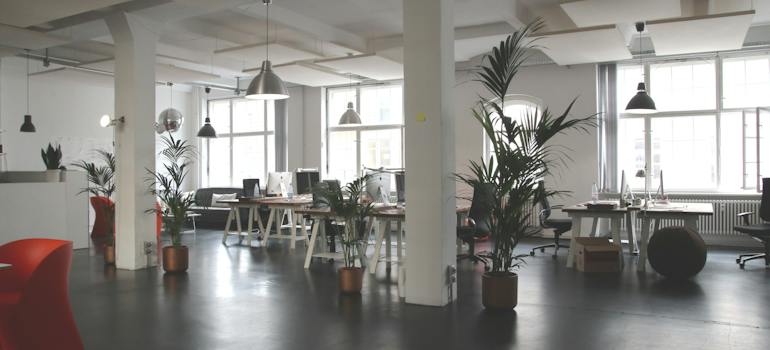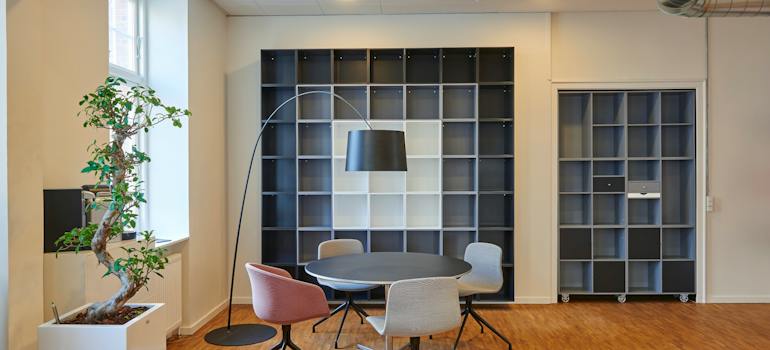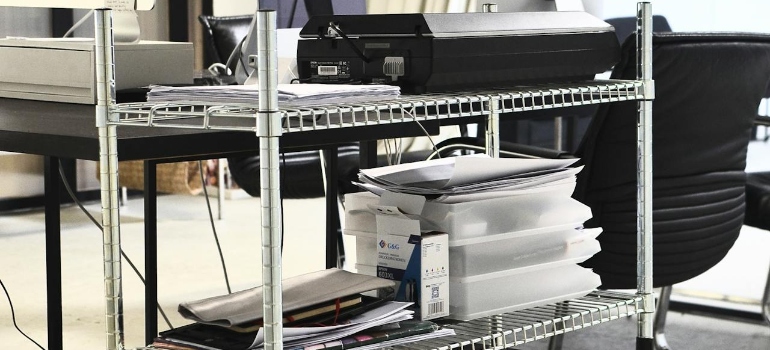Efficient Layouts for Storing Idaho Office Supplies and Equipment
Efficient storage is a cornerstone of a well-organized and productive office environment. Faced with the challenge of managing limited space for a variety of office supplies and equipment, finding practical and innovative solutions for effective storage becomes essential. With this in mind, our Boise moving and storage specialists are happy to provide valuable insights and strategies to optimize layouts for storing Idaho office supplies, enhancing both functionality and workflow.
Assessing Office Storage Needs
The first step in optimizing office storage is to assess storage demands thoroughly. This initial stage is crucial in setting the stage for a systematic and well-organized workspace. It forms the basis for all storage-related decisions and involves:
- Listing all items: Document every supply and piece of equipment currently in the office. This inventory will serve as the foundation for all subsequent decisions.
- Evaluating Space Requirements: Assess how much space each item requires. This evaluation should consider both the physical dimensions of items and their usage frequency.
- Understanding Accessibility: It’s vital to recognize which items employees need frequent access to. These should be stored in easily accessible locations.
Though seemingly straightforward, this first phase requires meticulous attention to detail and a clear understanding of the office’s operational dynamics.
Conducting a Thorough Inventory
Creating a detailed list of every piece of equipment in the office is the starting point. This list should include everything from pens and paper to larger items like printers and filing cabinets. The objective is to understand what is in the office. This inventory acts as a reference point, helping identify surplus items and understand what is essential, what might be missing, and what might be kept away in commercial storage. It also aids in forecasting future needs, ensuring that the office remains well-stocked and prepared for all eventualities.

Estimating Space Requirements
Once the inventory is in place, the next step is to evaluate each item’s space. This evaluation is twofold: it involves considering the physical dimensions of each item and understanding its usage frequency. Larger items that are seldom used might need different storage solutions than smaller, frequently used items. This assessment helps determine the type of storage solutions needed – whether spacious cabinets for bulky items or smaller, more accessible storage for regular-use items.
Assessing Accessibility
Understanding how often different items are used and by whom is essential in determining their placement. Frequently accessed items should be stored in easily accessible locations to enhance efficiency and reduce time wastage. This step requires input from the employees who use these items daily. Their insights can provide invaluable guidance on which items should be prioritized regarding accessibility.
Integrating the Assessment into Storage Planning
This comprehensive assessment is a strategic approach to understanding an office’s storage needs dynamics. It helps in identifying inefficiencies and areas for improvement. Carefully analyzing both the inventory and space requirements and integrating employee accessibility needs, an office can design a storage solution that is both efficient and conducive to a productive work environment. This approach ensures the final storage layout is practical and tailored to the office’s and its workforce’s specific needs.
Space-Efficient Storage Principles
Adopting space-efficient storage principles is essential for enhancing the functionality and organization of an office environment. These principles optimize available space, creating a more efficient and orderly workspace. Three key strategies include:
- Vertical Storage and Multi-functional Furniture: Vertical space and furniture serving multiple purposes can dramatically increase storage efficiency.
- Ergonomics in Storage Design: The placement of items should minimize strain and maximize employee comfort.
- Clutter Reduction and Navigation: Strategies to reduce clutter can improve navigation and efficiency within the office.
These principles, centered around making the most of available space, help create a functional and orderly workspace. They are instrumental in enhancing layouts for storing Idaho office supplies and their aesthetics and practicality.
Vertical Storage and Multi-functional Furniture
Utilizing vertical space involves installing shelves, wall-mounted cabinets, and stackable units. This approach is particularly beneficial in small offices where floor space is limited. For example, tall shelving units can store files and infrequently used items, keeping them out of the way yet accessible when needed.

Incorporating furniture that serves multiple purposes helps reduce clutter and free up space. For instance, a desk with built-in drawers and filing systems eliminates the need for separate filing cabinets. Similarly, seating with built-in storage compartments can hold office supplies or personal items, reducing the need for additional storage units. This approach saves space and creates a more streamlined and aesthetically pleasing office environment.
Ergonomics in Storage Design
Ergonomic placement of items involves organizing storage based on how frequently items are used and how physically demanding it is to access them. Placing frequently used items at arm’s length reduces unnecessary movement and increases efficiency. Storing heavier items at waist height can minimize the risk of strain or injury when lifting. Ergonomic storage solutions also include adjustable shelving and storage units, allowing for customization based on the users’ height and preferences.
Ergonomic storage also means considering the overall safety and comfort of the workspace. Ensure that storage units do not obstruct walkways or emergency exits and are stable and secure to prevent accidents. Additionally, ergonomic storage should consider the ease of use, with handles and drawers that are easy to operate and do not require excessive force.
Clutter Reduction and Navigation Strategies
Regularly reviewing and maintaining office items in storage to identify and remove unnecessary clutter is essential. A “clean desk policy” can encourage employees to keep their workspaces tidy and return items to their designated storage spaces. Additionally, labeling storage areas and implementing an inventory management system can help keep track of items and prevent overstocking, which often contributes to clutter.
The layout of storage units should facilitate easy movement within the office. This includes placing frequently used items in central, easily accessible locations and ensuring that storage units do not block pathways. Clear signage of stored items can also help employees quickly locate what they need.

Customizable Layouts for Storing Idaho Office Supplies
Tailoring storage solutions to specific office layouts is essential for maximizing efficiency and productivity in the workspace. Different office environments, such as open-plan, cubicle-based, or compact spaces, require unique approaches to storage.
Open-Plan Offices
In open-plan offices, where space is ample but often unstructured, the key is to create defined storage areas without disrupting the flow. Mobile storage units are ideal in these environments. They can be easily moved around to suit changing needs. Consider using low-height shelving units that double as room dividers, providing storage while subtly delineating different office areas.
For shared resources, centralized storage works best. A communal storage area with clearly labeled sections ensures that supplies are accessible to everyone and reduces clutter around individual workstations. Incorporating vertical storage solutions, like wall-mounted shelves and hanging file systems, can also maximize space.
Cubicle-Based Offices
Cubicle-based offices, with their defined personal spaces, call for individualized storage solutions. Under-desk filing cabinets are a space-saving solution that keeps important documents within arm’s reach. Overhead bins and shelves that attach to cubicle walls can also store less frequently used items without taking up desk space. For shared equipment like printers and copiers, a central location equidistant from all cubicles prevents congestion and ensures equal access. Utilizing the corners of the office for these shared spaces can also be a smart way to use often underutilized areas.
Compact Offices
Compact offices require a strategic approach to storage to avoid clutter. Vertical space is your ally here. Tall, narrow shelving units can store many supplies without occupying much floor space. Pull-out drawers and stackable bins can help keep supplies organized and accessible. In very tight spaces, multifunctional furniture is a game-changer. Desks with built-in storage, foldable shelves, and wall-mounted desks can provide work surfaces when needed and be tucked away to free up space.
Flexibility Through Adjustable and Modular Units
Regardless of the office type, flexibility is crucial. Adjustable shelving and modular units, accompanied by furniture installation services, offer the versatility to adapt to changing storage needs. These systems allow for reconfiguration of storage spaces as the office grows or the nature of work changes.

In essence, efficient office storage is about understanding the unique dynamics of your workspace and choosing solutions that enhance both functionality and aesthetics. Whether through mobile units in open spaces, personalized storage in cubicles, or vertical solutions in compact areas, the right layout can transform an office’s operations.
Key Organizational Techniques
Effective organization in the workplace hinges on strategic sorting and categorization of supplies. This approach to designing layouts for storing Idaho office supplies can streamline workflow, save time, and reduce the frustration of locating necessary items. Here are practical tips for organizing office supplies for easy access:
- Group Similar Items Together: Keeping similar items in one place, such as all writing instruments like pens, pencils, and markers, makes it easier to find what you need quickly.
- Label Everything in Detail: Marking shelves, drawers, and storage bins with labels helps everyone know where to find and return items, maintaining order.
- Implement Color Coding: Color coding can identify different supply categories quickly. For example, blue for printing supplies and red for mailing materials aid in speeding up the search process.
- Schedule Regular Audits: Checking storage areas regularly to reorganize and declutter helps identify unused items and restock low supplies.
- Designate a ‘Return’ Area: Having a specific spot where employees can return items they’ve finished using keeps the workspace tidy and ensures items are put back in their proper place.
- Optimize Space Usage: Assess your storage setup regularly. Move frequently used items to more accessible locations.
- Inventory Tracking Apps: Digital tools like inventory management apps are useful for keeping track of supply levels. These apps can alert you when supplies are running low.
- Automated Reordering Systems: Advanced systems can automatically reorder standard supplies when they reach a certain threshold, ensuring you never run out of essential items.
- Digital Check-Out Systems: A digital check-out system for tracking who takes what supplies helps monitor usage patterns and plan future purchases more effectively.
Implementing these organizational techniques creates a more efficient, productive, and stress-free working environment. Moreover, regular upkeep and the use of technology for inventory management are key to sustaining this efficiency.
Overcoming Common Challenges
Designing office storage layouts often involves navigating through challenges such as limited space, budget constraints, and the varying needs of different departments. In offices where space is at a premium, the key lies in maximizing the use of vertical space. Employing tall shelving units and wall-mounted storage options can significantly increase storage capacity without encroaching on valuable floor area. This approach is particularly beneficial for smaller layouts for storing Idaho office supplies where every square foot counts.

Another common challenge is budget constraints. Here, opting for multi-functional furniture can be a savvy solution. Furniture that serves dual purposes can reduce the need for separate storage units. Desks with built-in storage or seating with internal compartments save space and cut expenses, offering a practical solution for budget-conscious businesses.
Additionally, addressing the diverse storage needs of different departments requires a flexible approach offered by off-site, on-demand storage Boise provides. And when it comes to on-site, customizable storage solutions that can be easily reconfigured or adjusted are ideal. This flexibility allows the storage system to evolve in tandem with the changing needs of the office, accommodating growth or shifts in departmental requirements without necessitating major renovations.
Enhancing Workplace Efficiency through Strategic Storage
The essence of an effective office storage system extends beyond the mere organization of items. It involves creating an environment that fosters efficiency, minimizes clutter, and is responsive to the changing needs of the business. Careful consideration of storage solutions’ layout, organization, and adaptability enables businesses to craft orderly workspaces and elevate workflow and productivity.
As office environments evolve, the importance of well-planned storage solutions grows. Adopting these principles and continuously striving to refine storage strategies is essential for developing workspaces that are organized effectively and conducive to employee well-being and productivity. This approach to designing layouts for storing Idaho office supplies equips businesses to adeptly navigate the dynamic demands of the modern workplace.

Everyone from the packers to the movers were awesome! They were all very professional and showed up when they were supposed to. would definitely use them again.

